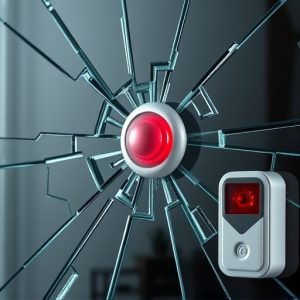Securing Your Space with Glass Break Alarm Sensors: A Comprehensive Guide
Glass break alarm sensors are sophisticated components within modern home and building security sys…….
Glass break alarm sensors are sophisticated components within modern home and building security systems, expertly designed to detect the distinct acoustic signatures of breaking glass. These sensors utilize advanced microphone technology and machine learning algorithms to differentiate between the sound of shattered glass and other ambient noises, ensuring high accuracy in detection while minimizing false alarms. They are strategically positioned at vulnerable points such as windows and doors to deter unauthorized entry and provide an immediate alert upon sensing an event consistent with broken glass, activating a swift response from occupants and authorities. The latest models offer integration with smart home systems for enhanced security and convenience, providing features like remote monitoring through mobile apps. As technology advances, these sensors are becoming more intelligent, with the potential to incorporate artificial intelligence for predictive threat detection, further solidifying their role as a critical layer of defense in comprehensive security strategies.
When it comes to safeguarding your home or business, a glass break alarm sensor stands as a silent sentinel, its sophisticated technology tuned to the acoustic signature of breaking glass. This article delves into the inner workings of these detectors, exploring their detection mechanisms and functionality, and provides a comprehensive guide on their installation for homeowners. We will compare glass break detectors with standard burglar alarms to highlight their distinct advantages and potential drawbacks. Furthermore, we’ll examine the latest innovations in this field and speculate on the future enhancements that promise even greater security. Understanding and utilizing a glass break alarm sensor can be pivotal in deterring intruders and ensuring peace of mind.
Understanding the Glass Break Alarm Sensor: Detection Mechanisms and Functionality
Glass break alarm sensors are pivotal components in security systems designed to detect the sound of breaking glass, thereby alerting occupants and authorities promptly. These sophisticated sensors utilize advanced technology, such as microphones or vibration detectors, to distinguish between the frequency patterns of glass breakage and other sounds. The detection mechanism typically involves analyzing audio frequencies; when a pattern indicative of broken glass is identified, an alarm is triggered. This process relies on algorithms that can differentiate between the specific acoustic signature of glass breaking and other noises, reducing false alarms. The functionality of these sensors ensures they are not sensitive to ambient noise or regular activities within a building, enhancing their reliability. They can be installed in various locations, such as windows and doors, where unauthorized entry is most likely to occur. By integrating a glass break alarm sensor into a security system, homeowners and businesses can significantly bolster their protective measures against potential intruders or hazards.
Furthermore, the sophistication of glass break alarm sensors continues to evolve, with newer models incorporating machine learning capabilities that adapt to the acoustic environment over time. This adaptability ensures high detection accuracy without the need for frequent manual adjustments. Additionally, these sensors can often be interconnected with other smart home devices and systems, allowing for a more comprehensive security solution that can respond dynamically to different threats. The seamless integration of glass break alarm sensors into modern security infrastructure not only enhances safety but also contributes to the overall efficiency and effectiveness of building protection systems.
The Science Behind Glass Break Detectors: How They Identify Breaking Glass
Glass break detectors are sophisticated acoustic sensors designed to alert home and business owners to the sound of breaking glass, a common sign of a security breach. These devices are integral components of a comprehensive security system, offering an immediate response to potential intrusions. The science behind these alarms hinges on advanced microphone technology that can distinguish between normal sounds and the distinct acoustic pattern produced by broken glass. When glass shatters, it emits a frequency-specific sound characterized by high-intensity transient signals followed by a series of resonant frequencies. Glass break alarm sensors are attuned to recognize these specific audio characteristics.
Upon detecting an event that matches the acoustic signature of breaking glass, the sensor triggers an alarm almost instantaneously. This rapid response is crucial for early detection and can serve as a deterrent to would-be intruders. The algorithms within these sensors are trained to differentiate between the sound of glass breakage and other common household noises, such as dishes clinking or windows slamming, which helps to minimize false alarms. This selective sensitivity ensures that security personnel or homeowners can respond promptly to a genuine threat without unnecessary disruption. Glass break alarm sensors are often integrated with video surveillance systems, providing a comprehensive solution that not only detects the sound of breaking glass but also provides visual confirmation of the incident. This synergy enhances situational awareness and allows for swift and informed action in the event of an actual security breach.
Installing a Glass Break Alarm Sensor: A Step-by-Step Guide for Homeowners
When enhancing your home security system, installing a glass break alarm sensor is a prudent measure to deter intruders and protect your property. This device is engineered to detect the distinctive sound frequencies emitted when glass is broken, triggering an immediate alarm. To ensure optimal performance and reliability, proper installation is key.
Begin by selecting a suitable location for your glass break sensor. Typically, it should be positioned near vulnerable points such as windows and doors. Avoid placing it too close to HVAC systems or speakers that might produce similar frequencies due to airflow or sound interference. Next, remove the outer cover of the sensor by unscrewing it gently. Position the microphone element carefully at a height where it can detect glass breakage effectively. Ensure the sensor is directed towards the glass panels and away from any potential noise sources inside the house. Once the optimal position is found, secure the cover back in place, making sure it is snug but not obstructing the sensor’s functionality. Connect the sensor to your existing alarm system following the manufacturer’s wiring diagram. Test the sensor by gently breaking a piece of glass near it; if the alarm activates, you have successfully installed your glass break alarm sensor. For best results, conduct a full system test and adjust sensitivity settings as necessary to minimize false alarms. Regular maintenance checks are also recommended to ensure the sensor remains sensitive and in good working order.
Glass Break Alarm Sensor vs. Standard Burglar Alarms: Comparative Advantages and Disadvantages
Glass break detectors, commonly referred to as glass break alarm sensors, are specialized components within a home security system designed to trigger an alarm upon the sound of breaking glass. These devices utilize advanced microphone technology to distinguish between the frequency of glass breakage and other sounds, effectively serving as a first line of defense against intruders. Unlike standard burglar alarms that may only detect door or window openings, glass break sensors provide an additional layer of security by alerting homeowners to potential breaches through windows or glass surfaces before the point of entry is even compromised.
A glass break alarm sensor’s ability to pinpoint the exact location where the break occurred is a significant advantage over standard burglar alarms. This precision allows for quicker response times from security personnel and enables homeowners to assess the situation more efficiently. However, these sensors are not without their limitations. They are highly sensitive to specific frequencies, which can sometimes lead to false alarms if environmental factors like wind or construction produce similar sounds. In contrast, while standard burglar alarms may not offer the same granularity in detection as a glass break sensor, they often include a range of other features such as motion sensors, contact sensors for doors and windows, and the ability to integrate with smart home systems. The choice between a glass break alarm sensor and a standard burglar alarm should be based on the specific security needs and vulnerabilities of a home or business. Both have their roles in protecting property, with glass break sensors excelling in detecting only glass breakage sounds and standard burglar alarms offering a broader range of detection capabilities. Integrating both systems can provide comprehensive security coverage.
Enhancing Security with Advanced Glass Break Detectors: Features, Innovations, and Future Prospects
Glass break alarm sensors have evolved significantly, becoming a cornerstone in enhancing security measures for residential and commercial properties alike. These sophisticated devices are engineered to detect the sound patterns associated with broken glass or the distinctive acoustic signature of glass being tampered with, distinguishing them from ambient noises. The latest innovations in this field leverage advanced algorithms and machine learning techniques, enabling more accurate and rapid detection capabilities. This progression not only speeds up response times but also reduces false alarms, ensuring that security personnel can focus on genuine threats without the interference of nuisance activations.
Furthermore, the integration of glass break alarm sensors with smart home systems and IoT platforms has opened new avenues for security enhancement. These devices are now equipped with features like remote monitoring, which allows users to keep an eye on their premises from anywhere via a smartphone app. Additionally, manufacturers are focusing on making these systems more energy-efficient and user-friendly, with designs that blend seamlessly into the environment without compromising on performance. The future of glass break alarm sensors is poised to bring even more sophisticated solutions, such as AI-driven analytics that can predict potential threats based on patterns and behaviors, thereby providing a proactive approach to security. As these technologies continue to advance, their role in safeguarding properties against intruders will only become more critical.


